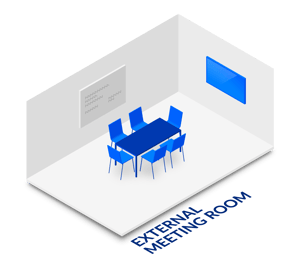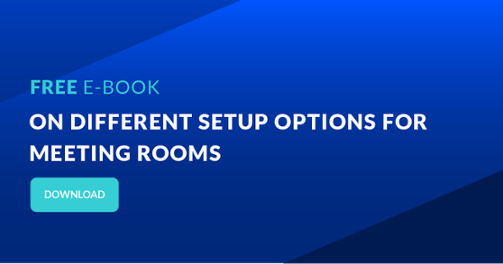A meeting room is never just a meeting room because they come in so many shapes and sizes and are utilized for different meeting purposes. If you do not define your rooms and their purpose, you can easily end up having a one-on-one meeting in a 12-person conference room. When you have not defined your meeting rooms for what they are or just have 20 of the same looking meeting rooms, you are making it difficult for your employees to find the right room matching their needs. In that case, your employees will book based on proximity if you give no constraints, limitations, or boundaries when booking a room. However, as an organization you would want people to book the room that is most suited for their meeting, and not just picking the room that is closest to them, or to the coffee machine, because otherwise you cannot ensure the best utilization of that exact room, can you?
However, if you bridge that gap between your rooms and the specific purpose of a meeting you can help your employees find a perfect fit, while at the same time, take care of the organization, so that you ensure that you get the most out of your investment in real estate, in meeting rooms, inflammatory space etc. We have listed all the different types of rooms that we have either in our platform today, or that we see is being requested as a support resource, and linked them to purpose to help you see the complexity of meetings and the way to optimize your meeting room facilities.
What types of meeting rooms can you have?
We can think of a palette of different types of rooms that are out there. If you want to change your employees' booking behavior you need to make sure you have a variety of room types to pick from so you get your employees inspired. So if your are are looking to redesign your office to fit current workplace design trends, get the complete list of resource options by downloading the list as an Ebook here. However, below we have handpicked some of them to help you understand what they look like, what you can pick from, and what typical settings there are.
If we start off in the smaller rooms and spaces, for one person or two. We have the regular desks and workspaces, meaning a regular bookable desk, but also everything from phone booths or the more relaxed high back private sofas.
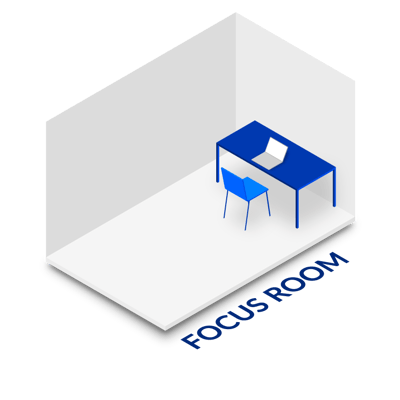 Then of course you have the more standard meeting rooms, with room for one to four people. That could be a standard default meeting room, internal meeting rooms or video meeting rooms for the smaller and maybe hybrid meetings that include video tech.
Then of course you have the more standard meeting rooms, with room for one to four people. That could be a standard default meeting room, internal meeting rooms or video meeting rooms for the smaller and maybe hybrid meetings that include video tech.
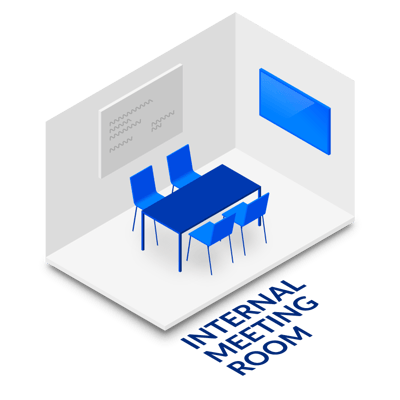
Next, we have the medium sized rooms with room for five to ten people. That could be the external meeting room for external visitors located close to the reception. It could also be the C-level room. A room which is only meant for private meetings among C-level attendees. These are often located close to their respective offices.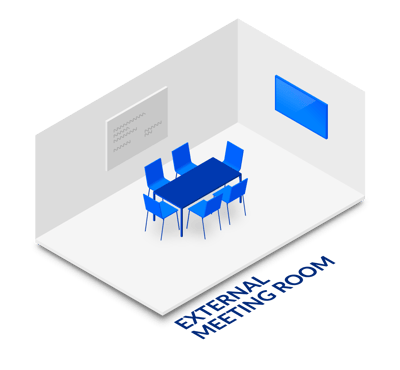
Lastly, we have the larger rooms and spaces for +10 people. It could be the workshop space or collaborative working space with a flexible setting, consisting of high and low tables including a variety of tools to facilitate communication, brainstorming, focus group workshops, roleplaying or expressing ideas on writable walls or flip boards. It could also be the conference room or the auditorium for presentations.
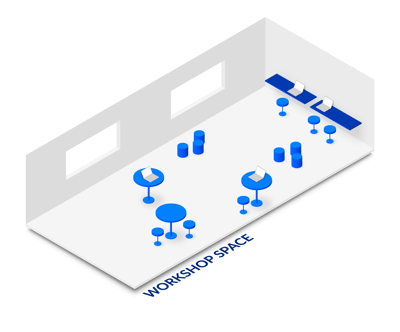
The point is, an Enterprise will need so many different types of meeting rooms, and in that case a meeting room is not just a meeting room – they come in so many shapes and sizes. It is a lot of rooms that needs to be booked, managed, scheduled, and analyzed. That is only the tip of the iceberg, because there is just as many meeting purposes that you need to consider to find the right room for your needs.
What types of meeting purposes are there?
On a high level we see three different meeting purposes, the including and engaging meeting, the more formal meeting, or the intense meeting. Again we have a palette of options and you can download the full list here. Below we have outlined some of the meeting purposes that supports the different meeting types just mentioned.
Firstly, the including and engaging meetings could be the classic team cadence which means the weekly team meeting, the daily huddle, the stand-up, or working sessions. It could also be the on-on-ones with the manager, the event planning meeting, or even the the team building workshop.
That is already a lot of meeting types. So let us move on to the formal meeting. That could be the governance cadence meaning board meetings, strategy review , or client QBRs, but it could also be the client training meeting or the press briefings.
Next, there are the intense meetings also called the purpose intense meetings which involves the problem-solving meetings such as incident response, or plan reset. It also means the introductions such as a sales call, the first interview, new candidate introductions, or an investor pitch.
In essence, no meeting room is created equally, and the same goes for the meeting purposes.
So, which meeting purpose fits what type of meeting room?
It is more complex than you might think. You need to be smart on this and acquire a solution that accommodates all these different needs to help you understand how those different rooms are booked and for what type of meeting. In that case, your scheduling assistant in Outlook is not going to be enough, because it gives the user too much freedom when booking. Meeting bookings is all about taking a purpose-based approach and start the meeting booking experience, by asking:
“What is the purpose of your meeting?”
This consideration will help people book the right type of room for their purpose and it will make the process a lot easier for them when the software itself point the correct room out. Additionally, it will help meeting- or hospitality managers, understand what goes on and give them better insight in booking behaviour and use of resources. It will also help you avoid not being able to accommodate a workshop or avoid that your employees think: “This room is irrelevant..”, or “There is no suitable room for my one-on-one”. You should be able to accommodate all those different needs we see in the hybrid workplace, and with your data on room utilization build the office matching your employees needs.



